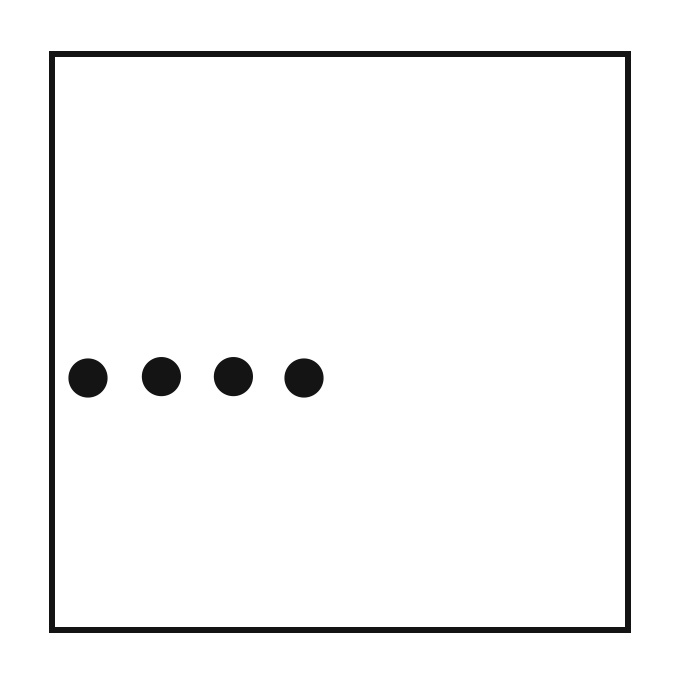
Find all numbers which are equal to the sum of the cubes of their digits.
A seemingly inocuous game (J. Hankins)
Here is a game played between two players Alf and Beth. Both players have a coin, which they each put down on the table simultaneously. They each choose whether to have the coin show heads(H) or tails(T). Depending on the following chart, either Alf pays Beth some money or vice versa.
Alf Beth | Beth gives Alf
H H | $3.00
H T | -$2.00
T H | -$2.00
T T | $1.00
(Here Beth gives Alf -$2.00 means that Alf gives Beth the money!) Note that if this game is played randomly, in the long run neither player is favored because the sum of the numbers on the right is 0. Nevertheless, does either player have a winning strategy?
Keep rolling the dice
Suppose you roll infinitely many fair dice. The first is two-sided, the second three-sided, the third four-sided, etc, and each die's faces are numbered consecutively from 1 to n. Prove or disprove: infinitely many dice will come up "1."
Tiling the square (D. Biddle) [Unsolved]
Can you tile the unit square with rectangles of dimension 1/k by 1/(k+1), using exactly one rectangle of each size for all k greater than or equal to 1? Note that the sum of the areas is exactly one!
An unusual tiling problem (D. Velleman)
Consider a square grid of (2n)(2n) little squares. Remove any of these squares from the grid. Prove that the remaining squares can be tiled by "L"-shaped tiles comprised of three little squares. For example, when n=1, the complement of any of the four grid squares is a tile of the correct form.
A 1974 Putnam Problem
Show that (1/Pi)arccos(1/3) is irrational.
Hint
Four oak trees (Sam Loyd)
Four brothers inherit a square plot of land which has four oak trees as in the
picture below. The will stipulates that the land is to be divided up into four
equal pieces, each containing one oak tree. How do they do it? In other words,
how do you divide the square into four connected regions of the same shape, each
containing one of the dots?

Infinitely Gregarious (I. Tuba)
Suppose there are an infinite number of people at a party. Any two
people are either friends or not. You can't say "I'm a friend of Bill, but he's not a friend of mine." Prove: there are either an infinite number of people
none of whom are friends, or there are an infinite number of people, every pair
of which are friends.
Hint
The bus problem (M. Thistlethwaite)
Conversation overheard on a bus:
A. The sum of my children's ages is the number of the bus, and
their product is my own age.
B. Perhaps if you told me how many children you have and also your age,
I could work out their ages?
A. No, that would not be possible.
B. Aha! Now I can work out your age.
What was the number of the bus?
Hint
The box problem
Let a box be defined as a polyhedron with all right angles. (It is the three-dimensional version of a rectangle.) Suppose you have a box which is subdivided into smaller boxes, and all the smaller boxes have at least one side which is of integer length. Show that the large box must also have a side of integer length.
Remark: This problem works for n dimensional boxes as well.
Hint
Colored dots in the plane
Suppose every point in the plane is colored by one of three colors. Show that
there exist two points which are of distance one apart that are colored
by the same color.
Hint
The fuse problem
Suppose you have two (not neccesarily identical) fuses that each take
exactly one hour to burn. However,
they burn at variable rates, sometimes fast, sometimes slow.
The problem is,
how do you measure exactly fifteen minutes? All you have is the two fuses
and a lighter.
Hint
The colony of logicians in the desert
There once was a colony of strange logicians somewhere in the Anza-Borrego
desert that had a curious and morbid custom. Each member had either brown or
hazel eyes. If a logician ever found out his or her eye color, he or she had
to commit suicide! Luckily in the desert, there is very little water, so
they never would see their reflections that way. Curious about these people, I
travelled to their colony after a long, arduous trek, and discovered that
there were 87 people in the colony. 35 of them had hazel eyes and the rest
had brown eyes. I found it strange that they had exactly two eye colors
and so I asked them, "How come not all of you have the same color eyes?"
They looked at me in horror, and soon thereafter, all the people with hazel
eyes killed themselves, immediately followed by their brown-eyed compatriots.
I've been riddled with guilt ever since. Can someone please explain what
happened?
There is a
variant of this problem with fewer hidden assumptions. Try not to peak at
the solution.
Note: Many people reach this website because they want to know the definition of hazel eyes. Here it is: light reddish-brown or yellowish-brown, usually flecked with green or grey.